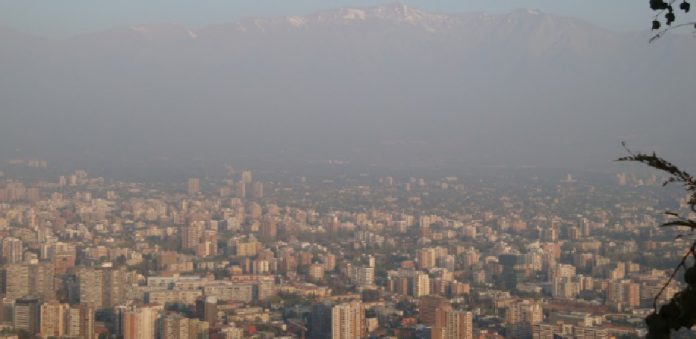By Rodrigo Seguel, full-time researcher at Center for Climate and Resilience Research (CR)2.
Thousands of volatile organic compounds (VOCs) coexist in the atmosphere due to natural emissions from both terrestrial and marine ecosystems [1]. These emissions are estimated to be ten times higher than human emissions [2]. These compounds participate in numerous complex chemical reactions that determine fundamental properties of the atmosphere, such as oxidative capacity. Furthermore, VOCs directly or indirectly influence the balance of other short-lived greenhouse gases such as ozone and methane [3].
Since the industrial revolution, human emissions have impacted the atmospheric system beyond its capacity for resilience. Temperature rising due to greenhouse gases increases natural emissions, causing feedbacks between the chemical composition of the atmosphere and the climate and reversible and irreversible impacts on the Earth system [4].
VOCs of anthropogenic origin are emitted from various sources that include fossil fuels, vehicle exhaust, solvents used by the chemical industry, and aerosols for domestic use. On an urban scale, exposure to certain VOCs is a threat to human health due to their toxic properties. Benzene, for example, is a known carcinogen [5]. For this reason, the European Union established that benzene in the air should not exceed 1.6 parts per billion by volume (ppbv) as an annual average.
The degradation of VOCs in the atmosphere (oxidation) produces a high number of toxic by-products that affect health and ecosystems, and agricultural productivity. For this reason, VOCs are also known as precursors to other pollutants, some regulated, such as nitrogen dioxide, ozone, and fine particulate matter. Therefore, proper VOC management would be highly beneficial in Santiago, saturated by ozone more than 20 years ago [6].
In this context, the approach used by the United States Environmental Protection Agency in ozone-saturated areas monitors 65 priority and optional VOCs according to their dangerousness and ability to form ozone and secondary particles.
Some VOCs can generate bad odors because they contain sulfur in their chemical structure. For this reason, it is common for industrial areas to report odorant gases that are very difficult to measure objectively due to the low detection thresholds of the human olfactory system and the short duration of the episodes. Dimethyl sulfide, for example, a natural species that is also used to odorize liquefied petroleum gas, can be perceived by the human nose at levels as low as 3 ppbv.
With all this, the massive poisonings of 2018 that affected more than 1,500 people in the Quintero-Puchuncaví bay evidenced the need to regulate VOCs. As a result of these dramatic events, the Ministry of the Environment began the preparation of the Preliminary Draft of the Primary Air Quality Standard for Volatile Organic Compounds. The creation of this standard represents a considerable challenge for society because it must define a reasonable VOC prioritization strategy for the entire country. In addition, the process requires knowing a priori the baseline of the selected VOCs, that is, the natural levels that would not represent a risk to the population over a period of time that allows, at a minimum, to know the daily and seasonal variability of said compounds. Also, a monitoring program must be implemented through a robust methodology that allows monitoring and evaluating this parameter throughout the country.
Pedestrians, athletes, children, and sensitive groups of the general population would constitute some of the primary beneficiaries of a norm that regulates the exceedance levels of these toxins. Having a target number that provides evidence on air quality is a long-standing desire for residents of communities near industrial zones highly impacted by gases, until now, of “unknown” origin. Therefore it would be an unquestionable achievement for transparency and public faith. Additionally, it would grant legal certainty, a fundamental element to declare saturated areas and establish decontamination plans.
Furthermore, the preparation of the preliminary draft of the primary VOC standard provides a space to discuss the application of environmental management instruments with a systemic logic that, although it focuses on public health, warns of the co-benefits derived from the protection of terrestrial ecosystems and the weather.
The ad portas debate constitutes, therefore, it’s an exercise that requires us to understand the atmosphere as a complex system, modulated by chemical equilibria, subject to change and which, consequently, urgently needs to be preserved for future generations.
References
[1] Goldstein, A. H., Galbally, I. E. 2007. Known and Unexplored Organic Constituents in the Earth’s Atmosphere Environmental science & technology 41:1514–1521 https://doi.org/10.1021/es072476p
[2] Williams, J. 2004. Organic Trace Gases in the Atmosphere: An Overview. Environmental Chemistry 1, 125–136 https://doi.org/10.1071/EN04057
[3] Young, P. J., et al. 2013. Pre-industrial to end 21st century projections of tropospheric ozone from the Atmospheric Chemistry and Climate Model Intercomparison Project (ACCMIP), Atmos. Chem. Phys., 13, 2063–2090 https://doi.org/10.5194/acp-13-2063-2013
[4] Steffen, W., et al. 2018. Trajectories of the Earth System in the Anthropocene. Proceedings of the National Academy of Sciences 115:8252–8259 https://doi.org/10.1073/pnas.1810141115
WHO. 2000. Air Quality Guidelines for Europe 2000, second ed. Copenhagen, World Health Organization Regional Office for Europe http://www.euro.who.int/__data/asset s/pdf_file/0005/ 74732/E71922.pdf
[5] Seguel, R. J., et al. 2020. Two decades of ozone standard exceedances in Santiago de Chile Air Qual Atmos Health 13:593–605 https://doi.org/10.1007/s11869-020-00822-w





